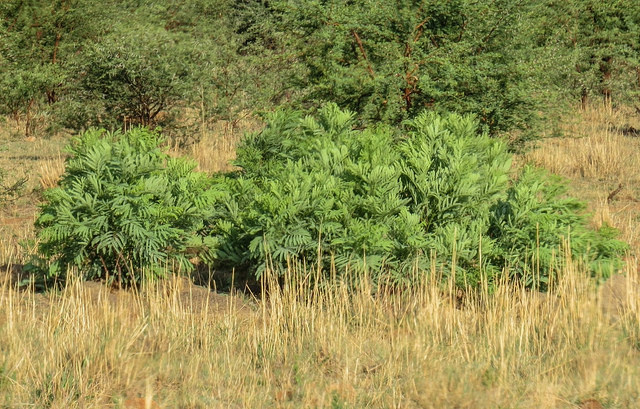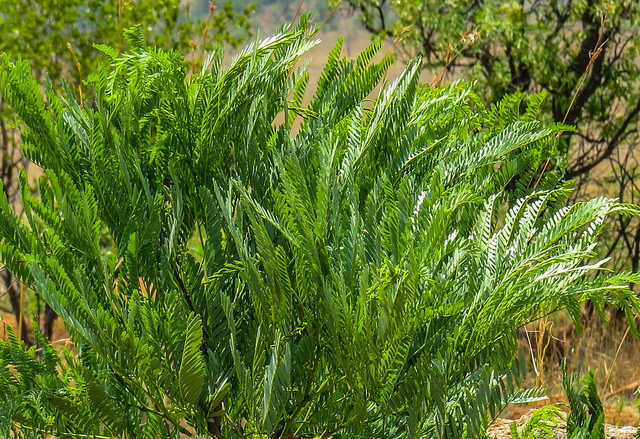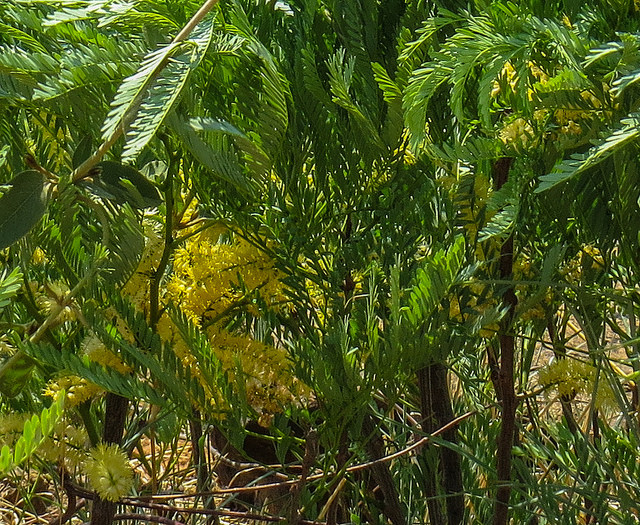Re: Africa Wild Tree & Shrub Book - Order Fabales
Posted: Tue Sep 09, 2014 8:01 am
164. Blue Thorn Acacia, Yellow-bark Acacia Senegalia erubescens, Acacia erubescens (Bouhaak, Withaak)
Order: Fabales. Family: Fabaceae. Subfamily: Mimosoideae




Pilanesberg
Description
Small to medium-sized, often multi-stemmed tree. Stem pale, fissured with a distinctly flaking bark, even on the smaller branches. Bark yeloowish, peeling. young branches usually hairy. Thorns hooked, dark tipped, c. 6 cm, in pairs at the nodes. Leaves about as wide as long; leaflets bluish, usually hairy below, widely spaced. giving the tree an open airy appearance. Leaves not large, up to 6 × 4 cm, with 4-7 pairs of pinnae; leaflets in 10-25 pairs per pinna, often slightly curved downwards; petiole fairly long, c. 1.3 cm to the first pinnae, with a raised gland near the base. Flowers (August to October) in axillary spikes, creamy white (sometimes pink), before or with the new leaves. Pods (September to January) straight, more or less oblong with conspicuous venation, leathery, pointed at the apex, dehiscent.
Distribution
Angola, Botswana, DRC, Namibia (dominant species in the central highlands and north-central plateau), Tanzania, Mozambique, Malawi, Zambia, Zimbabwe and northern South Africa (Limpopo, North West).
Habitat
In hot dry areas, arid bushveld, predominantly hill slopes, along dry watercourses and plains on rocky substrates.
Links: Ernst Schmidt, Mervyn Lotter, Warren McCleland: Trees and Shrubs of Mpumalanga and Kruger National Park; Tree Atlas of Namibia PDF; Sappi Tree Spotting: Bushveld, Including Pilanesberg and Magaliesberg
Order: Fabales. Family: Fabaceae. Subfamily: Mimosoideae




Pilanesberg
Description
Small to medium-sized, often multi-stemmed tree. Stem pale, fissured with a distinctly flaking bark, even on the smaller branches. Bark yeloowish, peeling. young branches usually hairy. Thorns hooked, dark tipped, c. 6 cm, in pairs at the nodes. Leaves about as wide as long; leaflets bluish, usually hairy below, widely spaced. giving the tree an open airy appearance. Leaves not large, up to 6 × 4 cm, with 4-7 pairs of pinnae; leaflets in 10-25 pairs per pinna, often slightly curved downwards; petiole fairly long, c. 1.3 cm to the first pinnae, with a raised gland near the base. Flowers (August to October) in axillary spikes, creamy white (sometimes pink), before or with the new leaves. Pods (September to January) straight, more or less oblong with conspicuous venation, leathery, pointed at the apex, dehiscent.
Distribution
Angola, Botswana, DRC, Namibia (dominant species in the central highlands and north-central plateau), Tanzania, Mozambique, Malawi, Zambia, Zimbabwe and northern South Africa (Limpopo, North West).
Habitat
In hot dry areas, arid bushveld, predominantly hill slopes, along dry watercourses and plains on rocky substrates.
Links: Ernst Schmidt, Mervyn Lotter, Warren McCleland: Trees and Shrubs of Mpumalanga and Kruger National Park; Tree Atlas of Namibia PDF; Sappi Tree Spotting: Bushveld, Including Pilanesberg and Magaliesberg



 © nan
© nan © nan
© nan


 © nan
© nan © nan
© nan





 © steamtrainfan
© steamtrainfan © steamtrainfan
© steamtrainfan © steamtrainfan
© steamtrainfan